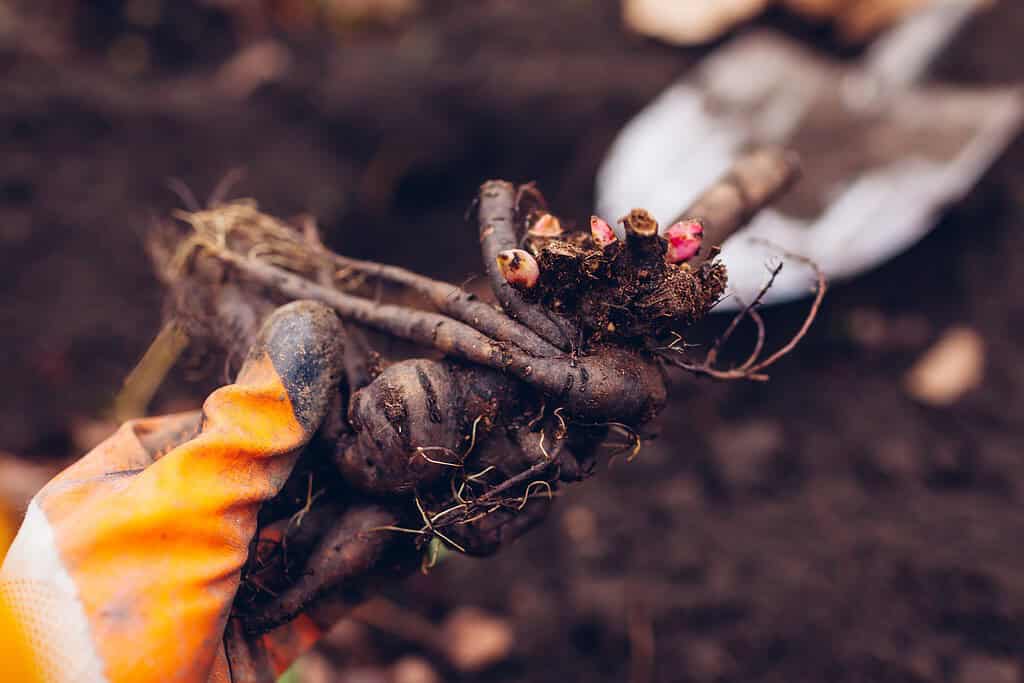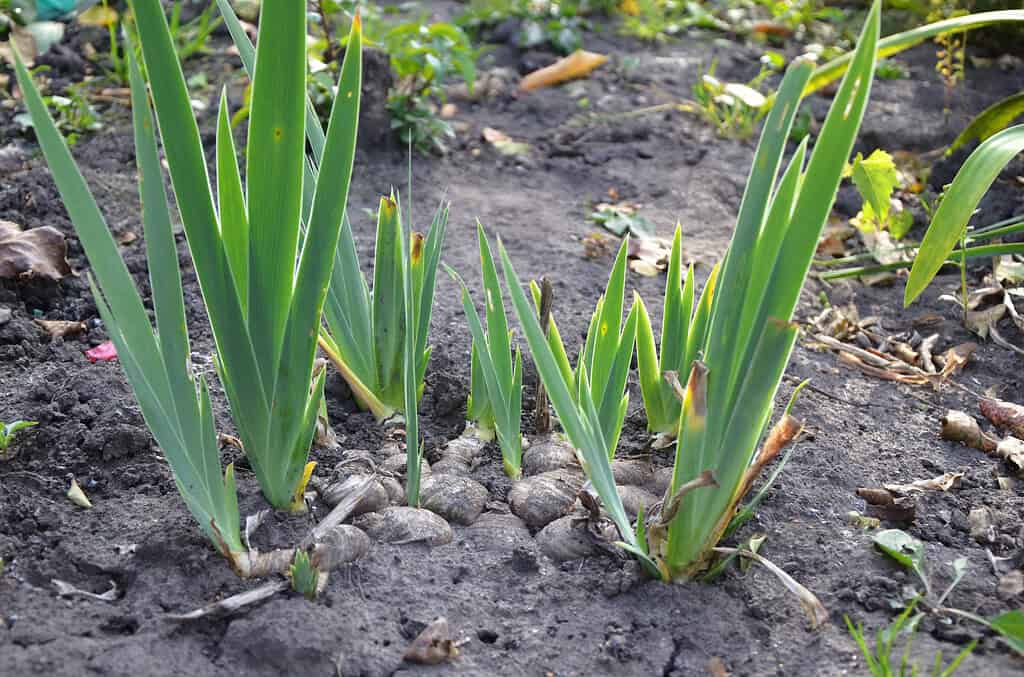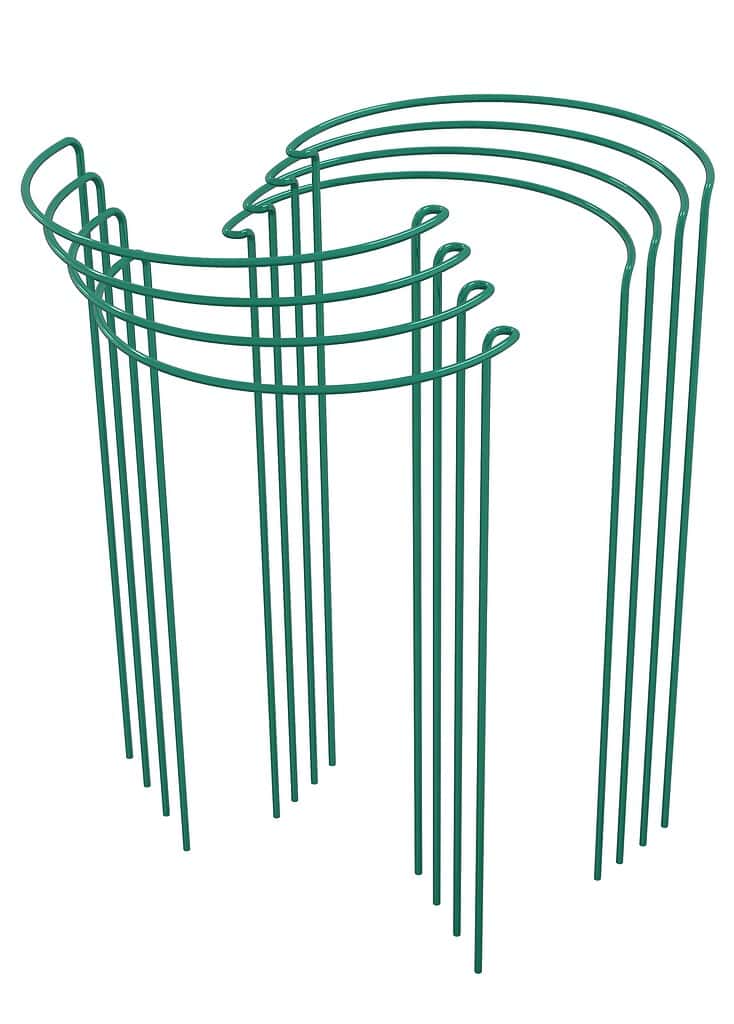Tubers will arrive in a state of dormancy. Most tubers can be immediately planted outside as they do not require protection from the cold. The exception to this is Dahlia tubers. Please see the Dahlia Care Guide for more information on Dahlias.
Tuber Handling and Placement
At Martin Garden Center, prior to planting all our bare roots, bulbs, tubers, or corms, we rehydrate them and activate them using a rooting solution. This involves soaking them for at least 1 hour in a mixture of water and rooting solution (we suggest Bonide Root & Grow), or soaking them in water for 1 hour and then placing tubers in a plastic bag of Bonide Bontone Rooting Powder and shaking the bag until the tubers are coated. The rooting hormone is not necessary but recommended by MGC and many enthusiastic gardeners.
For most tubers, insert your tuber so that the eyes/crown is up and the tubers are beneath it in a pyramidal shape. This is the natural shape so don’t worry about adjusting … just make sure the crown/eyes are up. Then add the additional soil mixture (devoid of bone meal) around the tuber. Ultimately, the eyes/crown should be buried approximately 1-inch beneath the top of the soil but the tubers themselves will be buried 5-6 inches.
Peony tubers can have eyes everywhere. Consequently, locate the eyes and do your best to plant your tuber at an angle where the uppermost set of eyes are approximately 1-inch beneath the top of the soil and the lower set of eyes is no less than 3 inches below the soil. Often this requires you to plant the Peony tuber horizontally.
For your Iris, make sure that the iris is planted with the tuber exposed on the surface. Planting your Iris bulbs deep is disasterous.
Planting Guidelines
Every smart gardener will tell you that proper soil and fertilization are the key components for optimum growing. Amend our native clay soil before planting your tubers. We recommend Mushroom Compost by Black Kow for Peonies. For Astilbe, Bleeding Heart, Daylilies, Hosta, Iris, Lilies (Asiatic, Oriental, Tiger and Trumpet), and Lily of the Valley, we recommend amending your clay soil with Soil Conditioner. By amending the soil, we mean dig 12 inches wide and 6-12 inches deep depending on the mature size of the plant. Then add back a mixture of ⅔ natural soil (lots of clay) with ⅓ amendment (Mushroom Compost or Soil Conditioner).
In Zone 8, you should plant your Peonies & Daylilies in 4-6 hours of afternoon sun. These plants can tolerate all day sun (8 hours) but they can also tolerate less than 4 hours of sunlight. Less sunlight can make for less growth and less blooms.
For Iris and Lily varieties, planting in afternoon sun or morning sun will work. For Astilbe, Bleeding Heart and Hosta, morning sun to shade is best as these plants don’t perform well in our hot afternoon sun.
Staking
With the exception of Peonies, these plants do not require staking. For Peonies, Martin Garden Center provides a wide variety of Peony staking solutions from single-bloom stakes to half-round supports to full rings. Bamboo Stakes are available at Martin Garden Center. We recommend Bond Garden Tape to secure stalks and larger flowers to Bamboo Stakes.
Mulching
Martin Garden Center does recommend mulching your tuber planting area but instructs all you mulch-a-holics not to let the mulch touch the stalk … keep it 3 inch diameter away from the stalk. And, don’t over mulch. Layer mulch 2 inches maximum for the spring. Please. Then in late fall, add more mulch for protection but remember to pull it away from the emerging foliage.
Fertilization
There a lot of debates about best fertilization for tubers. Martin Garden Center recommends use of Bone Meal when planting corms, bulbs and tubers. MGC also provides the following suggestions:
- For a one time fertilization, MGC recommends Fertilome Garden Cote, which provides a 6 month feed. This is the simplest and easiest fertilization method. MGC has used Garden Cote 6 for 10+ years and we believe it is the best slow release fertilizer on the market.
- If an organic solution is preferred by organic gardeners, we instead recommend Espoma Plant Tone. Espoma Plant Tone requires a little more maintenance as it should be applied every 4 weeks until mid-September.
- For supplements, we recommend Jacks Blossom Booster 10-30-20 every 2-4 weeks. It can be dissolved in water and sprayed on foliage as well as used for irrigation. Plants love it and respond well to a phosphorus boost.
- We highly recommend ending fertilization by mid- to the end of September because you don’t want plants trying to bloom when the temperatures are approaching frost.
Pest Alert
With emerging growth, watch for slugs or snails and control with Bonide Slug Magic if a problem occurs. Slugs are particularly fond of Hosta so watch these plants closely.
Voles love tender roots and tender bulbs, and they particularly enjoy hosta. Luckily, they can be deterred by planting your hosta within a gravel substrate. We recommend a thick layer on the bottom and sides, as well as gravel within the soil mixture. Voles love to tunnel through dirt, but they don’t dig through gravel. And, the gravel also helps to break up the heavy clay soil so it’s a win-win.
Deer also love Hosta and while some of the thicker blue Hosta can be slug resistant, they will never be deer-resistant. Good luck with keeping deer away … We have a myriad of deer repellants that work but they must be reapplied regularly. Try shavings of Irish Spring or place fencing on the ground around your plants as deer spook when walking on
Ants love Peonies. Peonies produce a sweet substance called extrafloral nectar on their buds. This nectar attracts ants, which eagerly harvest it. While foraging for nectar, ants help protect the Peony buds from other insects that might harm the blooms. They act as tiny bodyguards, warding off pests like aphids and thrips that can damage the flowers. So if you see ants on your Peonies, let them be. But, remember to gently remove them from your cut flowers before you take them inside.
Watering Guidelines
Tubers, particularly when in dormancy, are susceptible to root rot. Don’t overwater them. Water the ground only when it has been dry for a long time and nearby plants need to be watered. Ignore the tags on Astilbe, Bleeding Heart, Hosta and Lily of the Valley which suggest keeping these plants “Evenly Moist.” Let these under canopy plants dry before you water them. If you keep them constantly moist, the tubers will rot.



